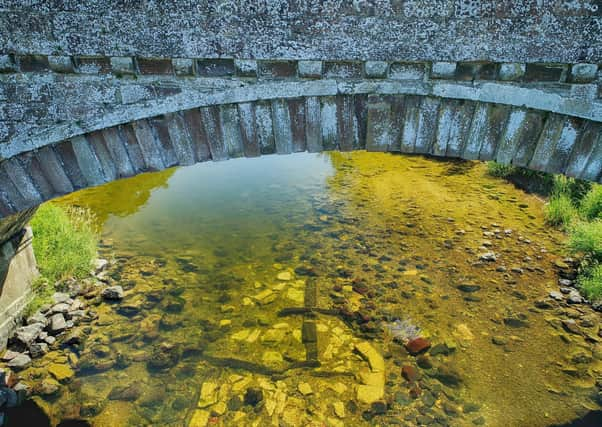Exciting discovery at Ancrum


Over the last two years, Historic Environment Scotland (HES) has funded the Ancrum and District Heritage Society (ADHS), a local volunteer archaeology group who, working in partnership with Dendrochronicle and Wessex Archaeology, undertook an investigation which led to the discovery of the ‘lost’ medieval bridge.
The Ancrum Old Bridge Project has used historical research, field survey, drone photography, dendrochronology, underwater archaeology and radiocarbon dating of the bridge timbers ... the former confirming a date of the mid-1300s, making this the oldest scientifically dated remains of a bridge ever found in its original position across one of Scotland’s rivers.
Advertisement
Hide AdAdvertisement
Hide AdInitial archive research by ADHS led to the discovery of cutwater platforms and oak timbers that once supported the piers of a multi-arched bridge. These are the last remaining, but crucially also the first built, parts of the bridge.
Geoff Parkhouse, from ADHS, said: “Ancrum Old Bridge now has a 14th Century date. In Scotland there is not a standing bridge that is earlier than the 15th Century.
“In those times, during flood or highwater, the bridge may have been the only place to cross the Teviot between Hawick and Berwick, making it one of the most important structures in medieval Scotland.”
Built during the reigns of David II of Scotland and Edward III of England, the bridge is of historic and strategic national importance, carrying the ‘Via Regia’ (The Kings Way) to the border.
Advertisement
Hide AdAdvertisement
Hide AdJames V would have crossed here in 1526, as would Mary Queen of Scots returning from her tour of the Borders in 1566, and the Marquis of Montrose on his way to battle at Philiphaugh in 1645.
Kevin Grant, archaeology manager at HES, said: “We are delighted to have played a part in funding one of the most exciting and significant archaeological discoveries in Scotland in recent years.
“This project shows that discoveries of immense importance remain to be found by local heritage groups – and what can be achieved by bringing archaeological science and expertise together with local knowledge which has helped to unlock a centuries-held secret that will add to the fabric of Scotland’s story.”
ADHS also enlisted the help of Coralie Mills of Dendrochronicle who helped them take samples of the timbers in the riverbed. She was able to identify them as native oak, which is rarely found in Scottish sites after around 1450 when imported timber becomes more frequent.
Advertisement
Hide AdAdvertisement
Hide AdUnderwater Archaeologists from Wessex Archaeology undertook a survey and assessment of the remains.
Timber samples were then sent to the Scottish Universities Environment Research Centre, in East Kilbride, for ‘wiggle match’ radiocarbon dating and returned the results, giving a date range in the middle of the 1300s.
Dr Mills said: “The timber structure discovered by ADHS in the River Teviot near Ancrum is a rare survival of part of an early bridge in a hugely strategic historical location. The oak timbers are in remarkably good condition and provide really important local material for tree-ring analysis in a region where few medieval buildings survived the ravages of war. It has been a privilege to work alongside ADHS on investigating this important structure.”
Dr Bob MacKintosh of Wessex Archaeology Coastal & Marine said: “The site was challenging to survey, and particular river conditions were needed to complete it safely. The regular monitoring of the site by ADHS, and the excellent photography and surveying they completed prior to our involvement made our work a lot easier.
Advertisement
Hide AdAdvertisement
Hide Ad“The results are really exciting. In addition to the surprisingly early date, it seems the foundations were built using branders, a wooden frame laid on the riverbed upon which the courses of stone were placed. This is the first-time branders have been found in an archaeological context in Scotland. They are otherwise only known from historical sources and two accounts of engineering works on extant bridges completed in the 19th and early 20th century.”
Comment Guidelines
National World encourages reader discussion on our stories. User feedback, insights and back-and-forth exchanges add a rich layer of context to reporting. Please review our Community Guidelines before commenting.